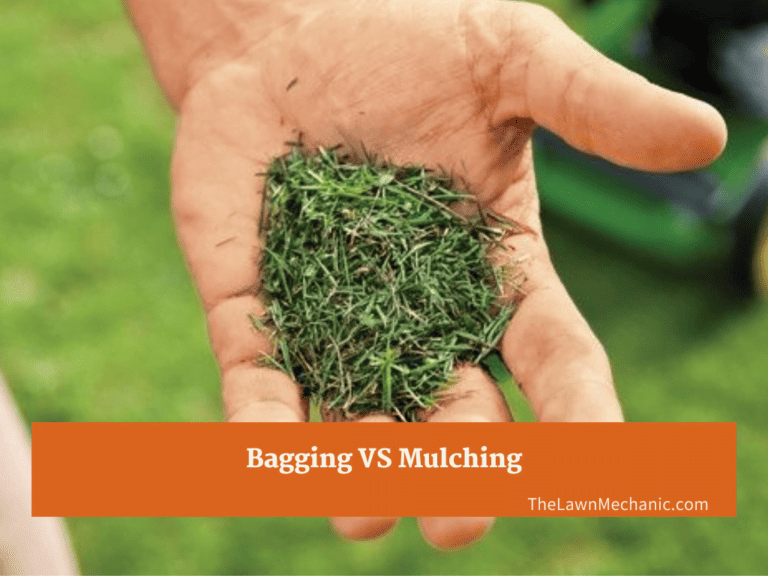A lush, healthy lawn is the pride of many homeowners, and keeping it well-maintained can often be an ongoing battle against invasive weeds, water shortages, and weather indecision. It’s a well-known fact that mowing is a vital aspect of any lawn maintenance strategy, but there are complications to this basic principle: the ever-present debate between bagging and mulching.
Both methods present valid arguments and serve unique purposes, which can be difficult for many homeowners to determine the best course for their lawn care. To help, this comprehensive article will break down the differences between bagging and mulching and guide you to make the best choice.
Quick Links
Understanding Bagging
Bagging is the process of collecting the grass clippings in a bag attached to the lawn mower after each cut. This method helps maintain a clean and manicured appearance, as the clippings are immediately removed from the lawn surface. Here are some of the benefits and drawbacks of bagging:
Pros of Bagging
- Removing clippings leaves a neat, well-groomed look to the lawn.
- Accumulated grass clippings can lead to a thick layer of thatch, which can suffocate the lawn and limit water and nutrient absorption.
- Bagging helps limit the spread of lawn diseases, as infected clippings are removed and not left to multiply on the lawn surface.
- Fewer clippings mean fewer hiding places for pests such as rodents and insects, helping you to keep them under control.
- Bagging is advantageous on inclined or slopy areas, helping to remove the slide risk posed by wet clippings.
Cons of Bagging
- Grass clippings contribute to yard waste, which may require additional disposal costs or extra work in composting them.
- Removing the clippings also takes away valuable nutrients that could be returned to the soil through decomposition.
- Bagging requires additional time and effort, as it involves stopping the mower often to empty the bags.
Understanding Mulching
Mulching, on the other hand, is the process of leaving grass clippings on the lawn after mowing, allowing them to decompose and return nutrients to the soil. Most modern lawn mowers have mulching capabilities, finely chopping the clippings and dispersing them evenly across the lawn. Here are some of the benefits and drawbacks of mulching:
Pros of Mulching
- As the clippings decompose, they return vital nutrients such as nitrogen, potassium, and phosphorus to the soil, providing a natural fertilizer for your lawn.
- Mulching helps preserve moisture in the soil by decreasing water evaporation and reducing the need for supplemental watering.
- A layer of mulch can inhibit weed growth by preventing sunlight from reaching weed seeds and germinating.
- Mulching reduces the need for synthetic fertilizers and requires less time and effort than bagging, as there is no need to empty and dispose of bags frequently.
- Mulching creates a sustainable gardening practice, as there is less waste production and recycling of nutrients within the lawn ecosystem.
Cons of Mulching
- While mulching can help reduce thatch build-up by returning nutrients to the soil, excessive clippings left on the lawn can eventually lead to a thick thatch layer, inhibiting water and nutrient absorption.
- Some homeowners may find the appearance of a mulched lawn less appealing than a bagged one due to the visible grass clippings.
- Mulching can be less efficient on wet grass or during rainy conditions, as clippings may clump together and not disperse evenly across the lawn.
- In areas with high incidences of lawn diseases, mulching can potentially facilitate the spread of these diseases, as infected clippings remain on the lawn.
Which Method Should You Choose?
The choice between bagging and mulching ultimately depends on your personal preferences, the specific needs of your lawn, and the prevailing environmental conditions in your area. To make an informed decision, consider the following factors:
Lawn Health: If your lawn is healthy and free from diseases or pests, mulching is a suitable option for recycling nutrients and maintaining overall well-being.
Aesthetic Preferences: If a manicured and neat appearance is a high priority for you, bagging may be the better choice.
Lawn Maintenance Schedule: If you mow your lawn frequently (ideally, cutting no more than one-third of the grass height per mowing), mulching can be beneficial, distributing finerclippings evenly and preventing thatch build-up. If your mowing schedule is less frequent, bagging might be more suitable, as longer clippings can lead to thatch formation or uneven distribution.
Soil Type and Climate: Consider the type of soil and the climate in your region. In arid climates or areas with sandy soils, mulching helps retain moisture and reduce water usage. In wetter climates or areas with clay-based soils, bagging may help prevent excessive moisture and favor grass growth.
Ultimately, there is no absolute right or wrong method, as both bagging and mulching have their benefits and drawbacks. You may find it helpful to experiment with both approaches and adjust your lawn maintenance strategy according to the changing conditions and needs of your lawn. By regularly assessing the health and appearance of your lawn, you can choose the most effective method for keeping it lush, green, and inviting.
Conclusion
Choosing between bagging and mulching for your lawn maintenance needs requires taking into account various factors such as lawn health, aesthetics, maintenance schedules, soil type, and climate. Both options offer unique advantages and disadvantages.
Whether you prefer the neat appearance of a bagged lawn, the nutrient recycling and moisture retention of mulching, or a combination of the two, assessing the specific needs of your lawn and adjusting your maintenance practices accordingly will ensure that it remains healthy and attractive for years to come.

